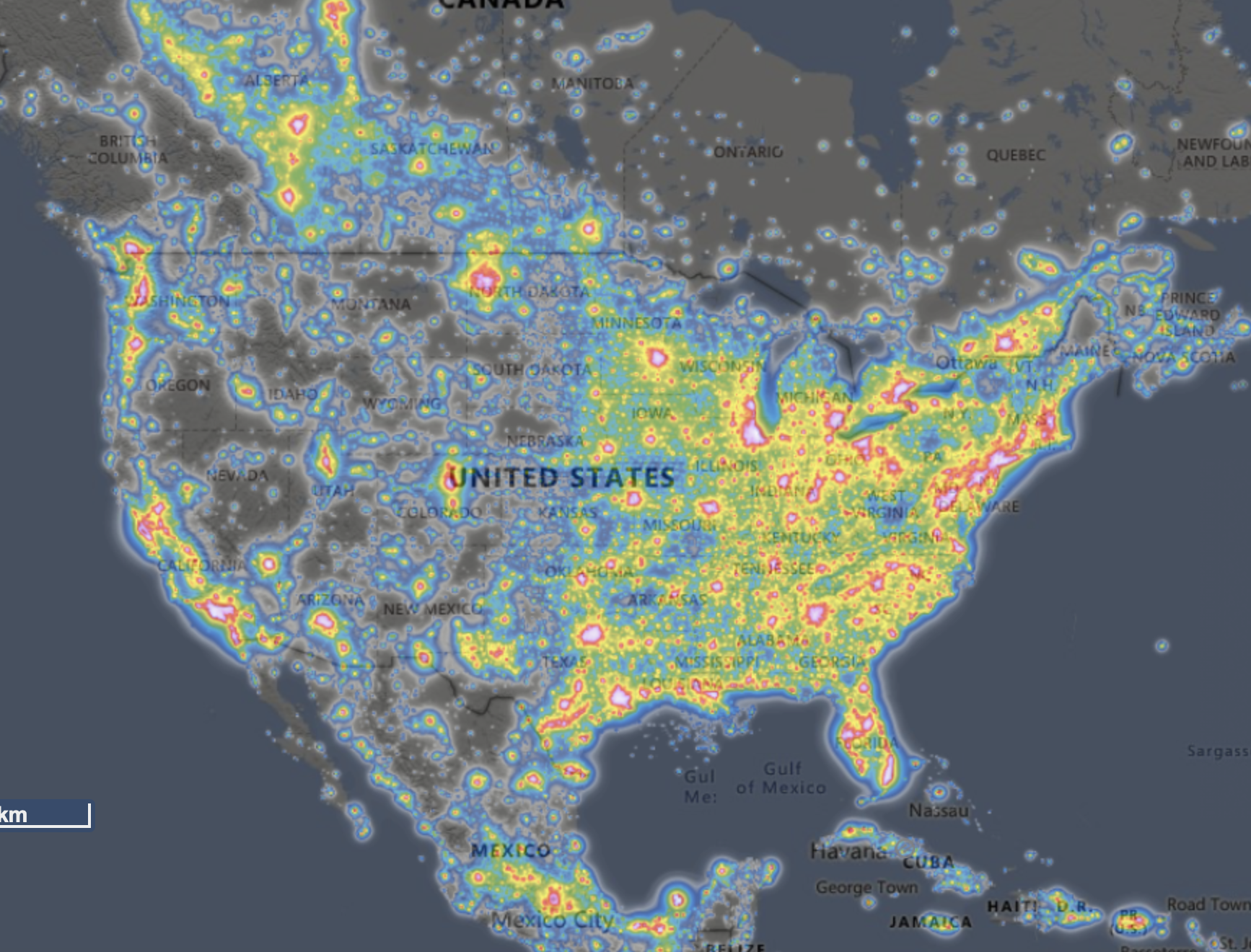Understanding Sky Glow and Its Causes
Sky glow is a pervasive problem affecting many municipalities worldwide, significantly reducing our ability to see the night sky. This phenomenon not only obscures the natural beauty of the stars but also has profound implications for insect and animal wildlife. In this three-part series, we will explore the causes of sky glow, its impact, and the measures someone can take to mitigate it.
 IMAGE TAKEN FROM LIGHTPOLLUTIONMAP.COM
IMAGE TAKEN FROM LIGHTPOLLUTIONMAP.COM
What is Sky Glow?
Sky glow refers to the brightening of the night sky over populated areas due to artificial lighting. This unwanted illumination scatters in the atmosphere, creating a glowing dome of light seen from miles away. The primary causes of sky glow are over-illumination, reflection, and light trespass.
- Over-Illumination: Excessive use of artificial lighting goes beyond what is necessary for visibility and safety.
- Reflection: Light bounces off surfaces like buildings, roads, and other structures, contributing to brightness.
Light Trespass: Unwanted or misdirected light that spills over into unintended areas.
The Impact of Sky Glow
The consequences of skyglow extend beyond the loss of stargazing opportunities. It disrupts ecosystems, affecting nocturnal wildlife and insect populations relying on natural darkness for survival. For instance, many insects navigate by moonlight, and excessive artificial light can lead to disorientation and death. Similarly, nocturnal animals may experience disrupted feeding and mating patterns.
Sources of Sky Glow
While poorly designed landscape lighting can contribute to sky glow, commercial and municipal lighting systems are the primary culprits. Sources include:
- Street Lighting: Inefficient or improperly shielded streetlights that emit light upwards.
- Commercial Buildings: Brightly lit facades and poorly designed exterior lighting.
- Parking Lots: Overly bright and non-directional lighting in parking areas.
- Wall Pack Lighting: Fixtures mounted on the exterior walls of buildings that often cast light in all directions.
A Growing Concern: Data Centers in Northern Virginia
Northern Virginia, particularly Prince William and Loudoun County, is experiencing a boom in data center construction. Often located in previously rural areas, these facilities can significantly contribute to sky glow if not correctly managed. The large, brightly lit campuses can turn previously dark skies into brightly lit ones, further exacerbating the issue.
Mitigating Sky Glow: The Role of Proper Design and Controls
To effectively combat sky glow, a multi-faceted approach is required.
- Proper Design: Ensuring lighting fixtures are designed to direct light downwards and reduce spillover.
- Luminaire Selection: Choosing the correct fixture and light output so that 99-100% of light is captured by the object being lighted.
- Controls and Motion Sensors: Implementing lighting controls, such as motion sensors, to reduce unnecessary lighting and energy when areas are unoccupied.
Dayloom’s Initiative
At Dayloom, we are committed to protecting the night skies. Our expertise in landscape lighting design extends to advising on municipal and commercial lighting projects to reduce sky glow. We are actively taking this initiative to local governments, advocating for better lighting practices and policies prioritizing preserving our night skies.
Resource for Visualizing Light Pollution
You can use resources like the Light pollution map to understand the extent of light pollution and sky glow in your area. This interactive tool allows you to see the levels of light pollution in various regions, helping to highlight areas most in need of lighting reforms.
The Cost of Inefficiency
It’s estimated that up to 40% of all city lighting is wasted into the night sky. This inefficiency contributes to sky glow and represents a significant waste of energy and resources. By addressing this issue through better design and technology, we can substantially reduce light pollution.
In the next part of this series, we will explore the specific design principles and technologies that can help mitigate sky glow, including examples of successful implementations in various municipalities.
Stay tuned for more insights on how we can all contribute to preserving the natural beauty of our night skies.

